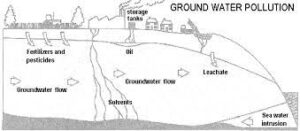
Ocean Water Pollution
Ocean water pollution is a mixture of chemicals and trash that is washed or blown into the sea. More than 80% of the pollutants come from land-based sources such as fertilisers, petroleum and human sewage.
Chemicals that enter ocean water cause harm to animals that consume them. They also reach human bodies through seafood consumption.
Causes
Ocean pollution includes the accumulation of toxins, trash and waste in seas and rivers. It is mostly caused by human activity, including the improper disposal of chemicals and waste. Most of the debris is washed or blown into the ocean from land. It can also include agricultural and residential waste, sewage, particles, noise and excess carbon dioxide.
Marine animals are often harmed by pollution in the ocean. Plastics, for example, are a frequent source of injury and death. They can entangle and suffocate animals that come into contact with them. They can also block gills, permeate feathers and cause behavioral changes in sea birds. Crude oil from oil spills can contaminate water and cause animals to die from suffocation or from heat exposure as they attempt to eat or reproduce.
Other sources of marine pollution include phosphates and nitrates from fertilizer runoff, pharmaceuticals and pesticides, and heavy metals such as mercury, lead and cadmium. These pollutants enter the ocean through streams, rivers and sewage systems. They can also be carried by storm drains and transported by currents to the coast or by shipping activities.
Some pollutants, such as PCBs, DDT, furans and radioactive waste, do not break down or degrade in the ocean. These substances are called persistent toxicants and can build up in the tissues of marine animals, causing disease, birth defects or killing them.
Effects
Ocean pollution is the introduction of harmful substances to marine environments. It can take the form of oil spills from ships, plastic and trash from humans who litter, sewage from factories, and fertilizers and pesticides from land-based sources. It can also cause the depletion of oxygen in seawater which can kill marine life and create areas known as dead zones.
Nonpoint source pollution typically enters the ocean via water runoff, where rain or snow carries pollutants from land into the ocean. For example, heavy rainstorms can wash oils left on roads from cars into the ocean, and dust in the air can be carried by wind to the ocean.
Chemicals, such as mercury, released by manufacturing plants can enter the ocean and poison marine life. Fertilizers like nitrogen and phosphorous, which are used on land, enter the sea and can cause eutrophication (excessive growth of algae), which depletes the amount of oxygen in the water. This depleted water kills fish and other marine life that cannot swim away, and causes a large area of dead zone in the sea.
Plastics are a huge problem for the ocean, and are becoming more widespread than ever before. They can clog up oyster reefs and sting and kill marine mammals who mistake them for food. They also release chemicals that mimic the scent of jellyfish which can lure sea turtles into eating them. They can also harm sea birds who become entangled in them and inhale the toxic fumes.
Symptoms
When humans get too close to the ocean, they introduce a mixture of dangerous pollutants into marine environments. This pollution includes toxic metals, plastics, manufactured chemicals, petroleum, pesticides, fertilizers, oil and sewage. These substances contaminate the sea and kill marine plants, animals and insects that live there. The water pollution can also affect the health of people who swim or visit beaches.
Bacterial exposure from polluted runoff and untreated sewage in recreational waters can lead to swimming-related illnesses such as gastroenteritis (nausea, vomiting, stomach cramps, diarrhea, chills, headache, fever) or skin and eye infections. Cyanotoxins produced by some types of algae in heavily contaminated coastal water can cause symptoms such as hay fever-like symptoms, skin rashes and sore eyes.
In addition to the effects of chemical contamination, ocean pollution includes noise from ships and sonar devices that disrupts natural sounds marine mammals use for navigation, feeding and communication. These disruptions can interfere with animal behavior and lead to behavioral changes or even death.
Plastic debris can entangle or suffocate marine animals. This can include dolphins, seals and turtles, as well as fish, birds and crabs. In addition, many sea animals mistake plastic bags for food and get entangled or suffocate in them. The effects of oil spills on marine animals are even more devastating, as they often die or become unable to reproduce after being coated with crude oil.
Prevention
The good news is that ocean pollution can be controlled and prevented. For example, improved wastewater management can prevent the release of plastics and other pollutants from entering the ocean. And reducing carbon emissions can reduce nutrient pollution that contributes to harmful algal blooms and the destruction of coral reefs.
Most ocean pollution comes from land sources, and much of it is caused by people. Big oil spills are responsible for only 12% of the pollution currently in our oceans, with most of it coming from smaller sources like oil runoff from cars and boats, home drainage and chemical use (herbicides, fertilizers, etc).
When shopping for household products, buy nontoxic cleaners that don’t contain harmful chemicals. Choose natural and organic foods, as well as sustainably caught seafood. Avoid cosmetics and jewelry made from shark squalene, as this supports unsustainable fishing practices that harm marine life.
When visiting beaches, don’t leave any trash behind — take a bag with you and pick up anything that can be found. Choose reusable water bottles and utensils, and opt for cloth bags when shopping. Avoid using pesticides, herbicides and conventional fertilizers on your lawn, as these chemicals can enter your drinking water. And be conscious of noise pollution — there’s hardly any place left in the world where you can’t hear military sonar, industrial shipping and airplanes flying overhead.


